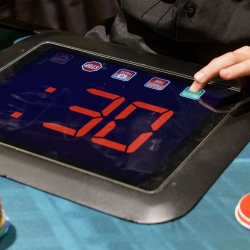The World Poker Tour is instituting a 30-second “action clock” to avoid tanking in the final stages of live poker tournaments. The WPT wants to eliminate gamesmanship, which causes delays for no apparent reason.
WPT Executive Tour Director Matt Savage said in a statement to PokerNews.com, “Many players, both recreational and professional, have expressed concerns that unnecessary tanking has taken a lot of the fun out of poker.”
The issue is one of fairness. Players trying to finish in the money or make it to the final table cause delays, hoping other players get eliminated in the meantime. Many professional and amateur card players view tanking as bad sportsmanship, or against the spirit of the rules.
Now, tanking is against the rules in the World Poker Tour.
Savage, who was nominated for the Poker Hall of Fame this year for his work as an event organizer, added, “Poker should always be fun, and it was a no-brainer decision to bring the action clock to all WPT events.”
What Is Tanking in Poker?
“Tanking” happens when a poker player takes a prolonged amount of time to make a decision. A increasing number of prominent poker players have argued for a “shot clock” of some sort, to keep opponents from tanking.
In the NBA, a 24-second shot clock was instituted in 1954-55. NCAA basketball instituted a 45-second shot clock in 1985-86, while eventually changing it twice more, before settling on the current 25-second clock. The NFL has a 40-second clock between plays, while ATP and WPT tennis have a 30-second clock between serves (which is seldom invoked). Even the World Chess Federation has a chess clock for FIDE tournaments.
Why Do Poker Players Tank?
During poker tournaments, players often tank when they reach the end stages of a tournament. As the final table approaches, some players tank in order to survive longer in the tournament. The tanker believes, if they delay playing long enough, their odds of making the final table increase.
Live poker events often have some manner of action clock, though it often falls to opponents to invoke the rule. For instance, Daniel Negreanu said prior to the World Series of Poker that he would call out tankers and ask dealers to add a time limit during WSOP events.
WPT Action Clock Rules
The new action clock rules for the WPT will go into effect when there is one table off (9 players) off from the money bubble. The rule is designed to assure each player in the event plays roughly the same amount of hands.
The WPT action clock is dealer-controlled, so no one has to ask for the shot clock. If a bet or raise is made, then the dealer restarts the 30-second count. Players cannot see the clock, so the dealer will announce when they are down to their final 10 seconds.
Extra Time Chips
When the “action clock” phase of the tournament approaches, each player will receive 4 “extra time” chips. These can be played by the players at any time. Each chip is worth another 30-second increment of time.
As the tournament gets down to the final three players, the extra time chips are replenished to six chips. When the event becomes a heads-up event, the extra time chips are replenished to 8.
The time chips will be treated like poker chips in WPT action. They must be visible to opponents at all time. When play is stopped for dinner or breaks, then the action chips will be bagged up.
When Time Chips Expire
If a player’s time chips expire and they have not made a play before the action clock expires, then they either check or fold. If no bet has been made by an opponent, then a player with expired time is forced to check. If any bet or raise has been made, then the player automatically folds.
WPT 8-Handed Tables
One other rule was instituted by the World Poker Tour. When play gets down to the final 80 players, then the tables will become eight-handed. This applies to all WPT tournaments.

